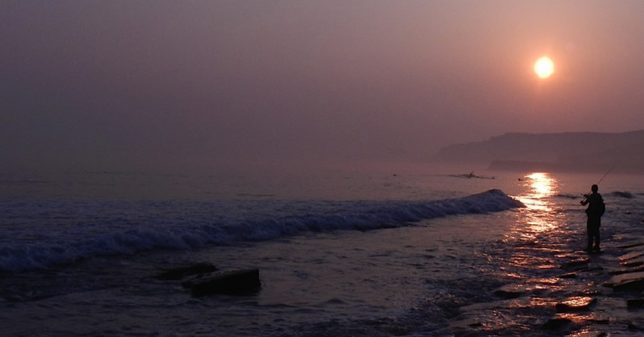CHAPTER 9 – ‘MORA’
Winter (Part 1)
Year followed year, and with the passing of time Mora grew to exceed 10lb. Her natural enemies became fewer and fewer and she left the shoal to hunt on her own. She was a creature of habit, and her life was governed by seasonal changes and migrations of the fish and crustaceans that were her main source of food.
With the advent of the winter gales, many of the fry and school fish had now moved away from the shallows, so Mora would feed on the crabs that remained inshore. When the frosts came to cool the waters of the bay they moved away the winter quarters, and it was then that Mora moved down the coast to the harbour.

The harbour lay still under the winter night sky, and along the quay the gulls rested one-legged on the cobblestones under the overhead lights. The sea had a gentle swell and the surface oil reflected a kaleidoscope of colour between the cluster of boats. Winter visiting herring drifters lay moored alongside the fish dock, the straining of their warps and rhythmic slap of rigging giving the only sounds to the sleeping town.
Mora swam in past the floating lobster courges at the outer entrance, and saw through the water the flash from the lighthouse as it sent its regular message of safety. She knew every inch of the harbour – she had explored it at different seasons, but as she grew older she went there only in late autumn and winter when it was quiet, hating the noise and commotion of the summer season. Even in winter, the roar of the engines discharging their exhausts underwater, and the propeller vibrations though the water were too much to bear, so here visits were confined to the hours of darkness when there was peace.
Near the middle ground buoy Mora picked up some small plaice on the sandbank then moved on to the old fish quay, a favourite haunt where there is always good feed from the fish offal washed from the boat decks. Competition for these scraps was fierce, for those not taken on the surface by the gulls were quickly seized by the waiting throng of crabs, which in turn were part of Mora’s catholic diet.
Large prawns lurked in the tangle of seaweed along the old sea wall, and until first light when the boats would be washed down, Mora flushed them out by thrusting her head deep into the wrack, working along the wall with her broom-size tail powerfully pushing her into the prawn-filled crannies. She knew that even for a fish of her size there were dangers to be avoided, and she was careful not to disturb the large conger living at the base of the wall.
Later on, Mora moved away when the daily bustle disturbed her; swimming quietly against the ebb tide she followed the main channel up past the town and into the wide estuary of the river. Salmon and sea trout swam alongside her, and coming to a wide bend in the channel she saw ahead the silver flashing sides of a salmon struggling to escape from the stake nets. Occasionally bass were taken in these nets, and Mora was careful to avoid them as she went upstream to the mussel beds.
These nets have been used since ancient times and the principle is used throughout the world. Fish are induced to enter the enclosure of nets by following a row of stakes set into the sand at an angle to the flow of the tide. The old netsmen knew that for some reason not properly understood, the fish possess a mysterious property known as rheotaxis, which makes the fish always tend to swim against the current at its strongest flow, and to keep an equal strength of current on each side of the body. The gaps between the stakes are wide enough for the fish to swim through, but since they must swim against the tide flowing at an angle to the row of stakes, they cannot approach the gaps at right angles. Therefore they pass from the slipstream made by each stake along the line and into the enclosure at the end.
Mora had been drawn to the enclosure years before when she was small, but had been able to swim through the mesh of the net, and ever since she had been careful to give the stakes and nets a wide berth.
Author: David Hill
Historical note: This article first appeared in BASS magazine no.94 Summer 2000.
Photo: Robert Pope
© Bass Anglers’ Sportfishing Society 2008